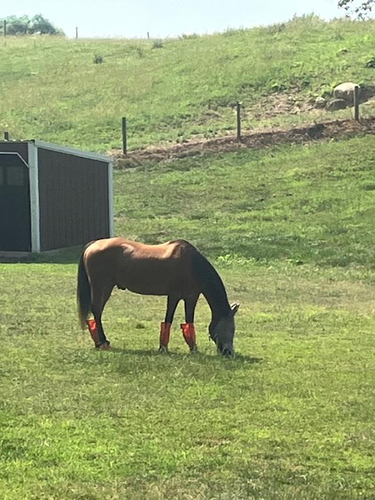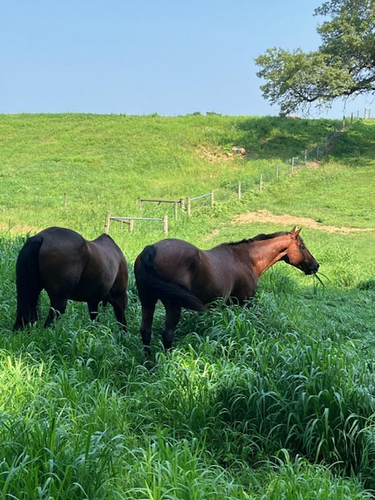AwiUsdi has good advice. Getting your local Extension agent involved to learn what edible plants you have for grazing will be helpful as well. Every area of the nation has specific issues a pasture grower has to deal with.
I am in Michigan where we usually have good rain to keep grasses growing well. Other locations may not have as much rain, so they need other care methods.
My regular mowing keeps the pastures growing and productive. This means I mow when grasses get 8-10 inches tall, reducing length to 6 inches. As mentioned, this height keeps leaf coverage over the soil, does not shock plant with excessive leaf removal. Shocked plants take time to recover, start growing again. Losing growth time can mean less production to graze on. Leaf coverage also softens rainfall, slows rain runoff, letting rain soak into soil, encourages root growth. Mowing at 8-10 inches helps prevent grass setting seed. Once it sets seed plant will go dormant, not grow at all!! This years job of reproducing itself is done… You sure want to avoid that!
Sharing your location, size of field will help us give you more specific advice.
Horses prefer tender new growth over tall green stems that are tougher. They will keep going back to new growth spots to graze, causing bald places, avoid the rich green tall stuff. The regular mowing will keep more new growth available for grazing, along with preventing tall weeds and grass going to seed.
I have a chain harrow (drag with teeth) that gets used on the fields as needed. It breaks up manure, spreads cut grass leaves around for better drying. I also spread the used stall bedding on my pastures as a soil ammendment. I do not compost because I want all the sawdust bedding being useful as a mulch to the plants. Sawdust also helps slow rain runoff, protects soil from hot sun and over time gets pulled into the soil by various microbial animals that break it down. I have heavy clay soil and the spread bedding particles helps keep clay particles spread apart to allow better drainage, plant root spreading, holds in nutrients for the plants. Before we started spreading that dirt was poor, SLIPPERY, not very good for growing anything but weeds.
I do not consider horse manure as being a great fertilizer, so we get our soil tested and purchase what the soil test says is needed for growing grass. I buy and spread the fertilizer each spring. If you get fertilizer, ask for Amonium Sulphate as your Nitrogen source instead of Urea. Cost is about the same, without the negatives that Urea can have with hooved animals. You have to ask for it or you will automatically get Urea as the default.
Our pastures have mixed plants, Orchard grass, Blue grass, Timothy, along with Birds-foot Trefoil, volunteer clover and alfalfa, so I cannot spray herbicides without losing the benefits of varied plants. I will spot spray weeds and under fences with generic round-up to keep fences hot. The varied planting ensures we always have something coming up for grazing. Droughts slow the grasses growth, but deep rooted clovers, alfalfa and Trefoil (adds nitrogen to the soil) all keep producing. Horses seem to like the dandelions and chicory too. I didn’t plant the clovers and alfalfa, but do benefit from them being blown in on the wind. No white trimmed horses to get photosensitive, and cut-off, short, red clover does not seem to cause slobbers. I may not mow if it seems to be going into a drought time. You have to make choices and then learn from those choices, how it affects the grazing. Even MORE fun is that seasonal weather is really unreliable these days!
I use a finish mower set at 6 inches behind the tractor for the fields. It does a better cutting job than the brush hog. Because it has 4 wheels, stays the same height all the time of cutting. Some folks use lawn tractors but even set high, they do cut grass pretty close. I cut the one barnyard with crab grass, using the lawnmower because the finish mower passes above with little cutting. Interesting because they are both set at 6 inches! Crab grass comes back every year after barnyard is a mud hole during winter and spring.
I also consider myself to be a “grass farmer” and want the horses out grazing instead of eating hay. We have between 6-9 horses grazing on about 11 acres, so those fields need to be very productive. Horses are all stalled a half day, out at night to avoid biting flies, not grazing continually. They work, are kept trim, no fat horses here! Even the retiree is athletic looking. Fields get rotated often, not grazed down to dirt. Drought times means a different field every day, letting previous field rest and grow a bit for a day or two. Plants recover faster when not stressed by overgrazing. I usually mow after horses are rotated off, but it can depend on weather. Right now all the fields are getting mowed weekly with the blessed rains. I had 5 inches growth in the last 10 days!! Horses are not making a dent with recent sun and rain!
Foxglove gave a cost for her mowing, but I consider regular (usually frequent) mowing to return good grazing benefits worth the cost in fuel and time spent. My Kubota seems to be extremely efficient in fuel use, with less than 5 gallons of diesel to mow all the acreage. Not a new tractor or a big one, 23HP. Finish mower is 5ft wide so it does take a while to get mowing done. Smaller mower fits well in small pastures and paddocks here, over a wider model.





 . That’s probably the tall green grass you’re seeing.
. That’s probably the tall green grass you’re seeing.